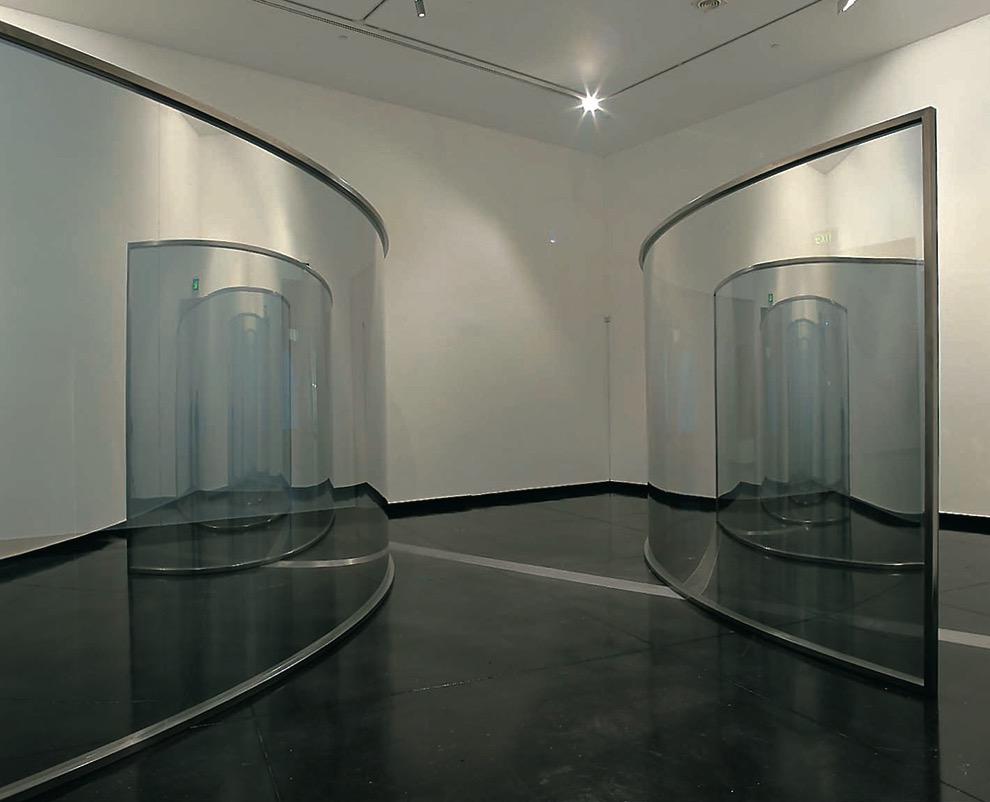The Visible and the Invisible
Australian Centre for Contemporary Art, Melbourne, 2004
Exhibited in Swoon, Curated by Juliana Engberg.



Materials: Polycarbonate, mirrored film, stainless steel frames, movement activated lighting.
Leslie Eastman has created a part architectural, part sculptural insertion into the ACCA galleries. Drawing on site-specific ephemeral installation practices, he uses the fugitive aspects of light, space and temporality. Composed of two-way mirrored glass, the structure is at once translucent and transparent, reflective and opaque. Through subtle modulations of light and movement, it fluctuates between the worlds of the gallery space-a shadow world of half seen realities- and the highly constructed artificial structure within a larger architectural form. It mediates between the specifics of the gallery and the broader opportunities it creates through its ever-shifting perspectives and possibilities.
While alluding to the pavilion style architectural forms of Dan Graham, Eastman’s work invokes an inverted parenthesis or open bracket. The opposite of containing or enclosing information, the outreaching arcs allude to a visual multiplication of possibility. Space and time flow unhindered. Through it, architectural form mirrors the cyclical viewing experience: the viewer looks at the object/the object reflects the gaze. Thus, the multiplicity of image, and distortion of shape become inherent in both the objects form and the process of looking at it. Also inherent in this reflected gaze are the mirrorings of the surrounding space- the architecture in which the form resides, its distance and relationship not only to the viewer but also to surrounding features and works of art.
Standing 2.5 metres high, the two curved screens, at once semi-transparent and highly reflective, are part sculptural entity, part architectural introduction. Referencing public and private, reality and interpretation, they force us to question ways of seeing and in turn being seen: of spectatorship and spectacle. As the viewer enters the dimly lit space, moves around the curved form, and enters the nexus of the form, their presence triggers a sensor, which slowly illuminates the central core. The addition of light renders the viewer crisply visible: from semi-translucent and suggestive, the surface becomes mirror reflective, positioning the spectator firmly on the outside.
There is an interesting participatory social character to the act of perception, as the reflection and refraction project and superimpose, however faintly, the viewer’s own image onto those of others. In every-day life, this sort of contemplation is usually solitary, however, here in the gallery space the process of viewing becomes an intrinsic element of the work’s thematic content. The viewer never escapes the possibility of becoming the object of perception. A consciousness of self is always present, through self images mirrored in the glass, as well as a self-consciousness of self in the consciousness of others.
Rebecca Coates, catalogue essay, Swoon.
“..But the most remarkable piece in Swoon is Leslie Eastman's large architectonic installation The Visible and the Invisible. The room contains two curved walls made of semi-reflective mirror glass in which your reflection is made wider. On the inside, where the mirrors are convex, you become very narrow. These transformations prepare you for the crisis of walking between the two walls on a Z-shaped excursion from door to door. Your reflection in one screen is seen in the other, so your image is replicated many times as you near the point of greatest convergence. But because the glass is only partially reflective, you also see the real space of the room through the glass. Thus the virtual reflections interfere with the spatial truth of the architecture, with chaotic perceptual consequences.
When you see your reflection in a mirror, you automatically adjust to all the terms of the virtual space, even though your size and movement in the mirror are different to those in real space. In Eastman's hall of semireflections, the co-ordinates of the room remain in place against their folded curving reflections; so the real and the virtual interact. Your whole spatial relativity is upended. The natural bounce of your gait seems to determine the horizon; so that your image remains constant while the room that you perceive around your image bounces up and down. The references of the real world and the virtual world are gently inverted, as your bobbing body is echoed in a framework that ought to be still.
When you enter the space from the far room, other reflections seem to intercept your pathway. I witnessed one person pawing the air, as if trying to remove a cobweb or a fly in front of her face. It was only the reflection of the architrave. Finally, however, you succumb to all disorienting rhythms; you drop the physics and enter into a world of baroque spatial swooning, as in the sumptuous architecture of Borromini 350 years ago”.
Reviewer Robert Nelson The Age, June 9, 2004